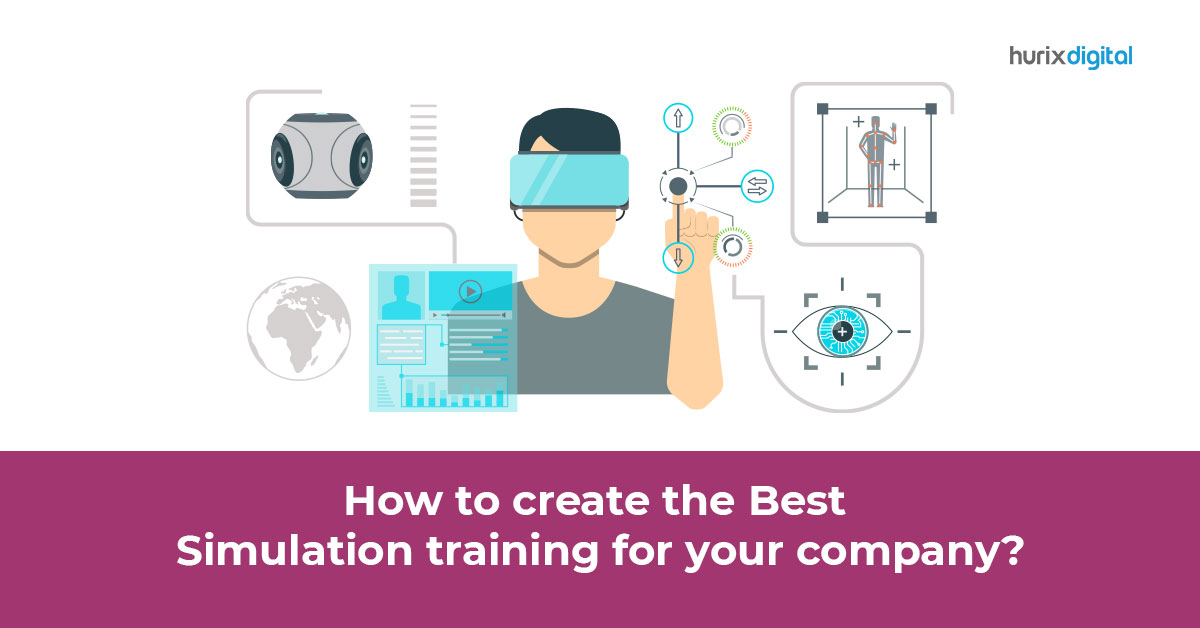
How to Create the Best Simulation Training for Your Company?
Summary
Tips for effective company simulation training: conduct skills gap analysis, set goals, brief simulations, test learning, gather feedback, and select platforms like Hurix.
Table of Contents:
- Introduction
- Ten Steps to Building the Best Simulation Training Programs for Your Firm
1. Start with a Skills Gap Analysis of Your Workforce
2. Identify Your Training Goals
3. Set a Budget for Simulation Training
4. Collect Training Material
5. Create Interactive Training Content
6. Build a Simple and Realistic Narrative
7. Keep Each Training Short
8. Test the Learners’ Learning Regularly
9. Develop a Feedback Mechanism
10. Select the Right Tool to Publish and Administer - Choose Hurix Digital for a Supercharged Simulation Training Program
Introduction
McKinsey research shows that since 2014, capacity building has been a key priority for companies worldwide.
Yet, even today, studies reveal that organizations need to learn to build these capabilities because they often don’t use experiential learning as a form of training.
Harvard Business Review cites how irrespective of the discipline, people who engage in the deliberate practice of skill sets in contained environments see a visible performance improvement.
Such “deliberate practice in contained environments” can only be achieved through simulation training. This article explores how companies can create effective simulation training programs to help them build capacity and achieve business goals.
10 Steps to Building the Best Simulation Training Programs for Your Firm
1. Start with a Skills Gap Analysis of Your Workforce
First, start with a skills analysis to identify what skills your workforce possesses and where the gaps exist. This should tell you what type of experiential learning you need to offer and how often to administer them to your employees.
2. Identify Your Training Goals
While capacity building is the primary, overarching goal, you will typically have smaller sub-goals within this to make simulation training more effective. For example, your goals may be:
- Reduced learner attrition
- Higher course completion rates
- Improved job performance post-simulation
- Increased employee confidence
- Better cross-team communication and collaboration
- Greater curiosity and lesser risk-averse tendencies
Ultimately, these sub-goals ensure your simulation programs have a positive impact on the firm.
Also Read: 6 Reasons Why Your Organization Needs Simulation Training
3. Set a Budget for Simulation Training
Simulations can get expensive very quickly because there are many technologically advanced options for companies to choose from. This is why it’s important to set a budget within which you will operate to ensure your training programs remain sustainable.
4. Collect Training Material from Within Your Workplace
When designing the actual simulation training module, start by collecting information from within your company. Experiential learning works best when it is implemented for scenarios that the employee will be a part of in reality.
So, it is important to understand the dynamics of any role within the organization’s scope and against the company’s operational framework and policies.
Consulting managers, speaking to employees who occupy those roles and identifying specific challenges and problem areas while understanding industry best practices can help you develop the most effective simulations.
5. Create Interactive Training Content Using a Versatile Authoring Tool
A robust and powerful authoring tool can help you put all the disparate training material you have collected into a powerful, interactive module.
Take an authoring tool like Hurix, for instance. Hurix has a massive library with customizable templates for various interactive content formats. It is easy to create simulations that use different elements such as videos, quizzes, polls, games, and more. There is also an option to implement AR and VR content that makes simulation more engaging.
You can merge multi-type content and create training material for various roles and hierarchies quickly and seamlessly.
Also Read – How Can Enterprises Implement Simulation Training for Employees
6. Build a Simple and Realistic Narrative in the Simulation
According to a study published in the Harvard Business Review, the narrative is the foundation of active retrieval.
According to research, a simulation narrative that is simple to understand, realistic to the learner, and fits within the constructs of the individual’s world offers meaning to an individual’s experiences.
This meaning helps them develop a mental framework that allows them to deal with similar future experiences smartly and creatively by retrieving associated memories and learning from them. Not only should there be a proper narrative within each training module, but there should also be a flow between multiple modules.
7. Keep Each Training Short
These days, learner attention span is decreasing at a rapid rate. Most of your employees may be patient in learning or trying simulations of 10-15 minutes. However, anything longer may not yield the desired results.
That’s why it’s best to keep all experiential learning programs short, under 10-15 minutes. One easy way to do this is to have simulations for small tasks or individual learning outcomes rather than a sweeping simulation for the entire role.
Having multiple short simulation exercises can allow your employees to build on their learning and gain higher-order skills, one at a time.
8. Test the Learners’ Learning Regularly
Just providing training isn’t enough. For training to stick, learners must implement what they have learned in practice exercises.
The good news is that the very nature of simulations gives employees a chance to learn and employ knowledge and skills simultaneously as the simulation training progresses. Besides the actual practice, role play, and other interactive activities, authoring tools like Hurix allow you to add text-based quizzes, essay questions, and MCQs into the training.
Also Read – 7 Ways to Leverage Simulation Training Across Industry Verticals
9. Develop a Feedback Mechanism that Can Help You Improve Training Quality
Regular tests and practice elements act as a feedback system that lets you know which areas of the simulation effectively meet your training goals and which don’t.
Additionally, monitor training analytics reports closely for information about engagement rate, course drop-off points, completion rates, transferability of skills, and other metrics. Usually, the tools that you use to publish and share your simulation training contain this analytics and reporting feature. Now, this brings us to our final step.
10. Select the Right Tool to Publish and Administer Your Simulation Training Modules
The choice of the correct content distribution platform makes all the difference when it comes to running a great simulation training program in your organization.
- For one, the right content distribution software will support multi-type content that is interactive and engaging.
- For another, it will allow you to develop a robust feedback system that will help you modify and develop better-quality training modules.
- Finally, the right content distribution technology will help you run a sustainable experiential learning program in a safe environment, giving your company a competitive advantage.
Choose Hurix Digital for a Supercharged Simulation Training Program
Hurix checks all three of the above points. In addition, we have over two decades of experience providing a robust authoring tool and content distribution platform for companies’ e-learning needs.
With Hurix, you can:
- Develop DRM and IPR-protected training content for your company.
- Take advantage of multi-type content templates to create interactive simulations.
- Organize content based on bespoke playlists.
- Control access to training simulations with identity-based verification.
- Prevent unauthorized downloads and keep a competitive advantage within the firm.
- Run numerous assessment programs and evaluate employee and team performance.
- Monitor simulation engagement metrics and make mindful training development decisions.
If this sounds exactly like what you were looking for, try the Hurix content distribution platform today.

A highly enthusiastic and motivated sales professional with over twenty five years of experience in solution selling of training-related applications and services. Maintains an assertive and dynamic style that generates results. Ability to establish long-term relationships with clients built on trust, quality of service and strategic vision. Specializes in financial services, higher ed, publishing and government in the areas of learning and development.






